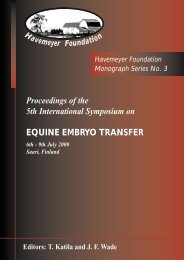Proceedings of a Workshop on - The Havemeyer Foundation
Proceedings of a Workshop on - The Havemeyer Foundation
Proceedings of a Workshop on - The Havemeyer Foundation
Create successful ePaper yourself
Turn your PDF publications into a flip-book with our unique Google optimized e-Paper software.
<strong>Havemeyer</strong> Foundati<strong>on</strong> M<strong>on</strong>ograph Series No. 11<br />
TREATMENT OF RECURRENT LARYNGEAL<br />
NEUROPATHY: EVALUATION BY RESPIRATORY<br />
SOUND ANALYSIS<br />
F. J. Derksen<br />
College <str<strong>on</strong>g>of</str<strong>on</strong>g> Veterinary Medicine, Michigan State University, 200 Westborough Road, North Graft<strong>on</strong>,<br />
Michigan 48824-1314, USA<br />
Upper respiratory disease is suspected in an<br />
exercising horse when an abnormal respiratory<br />
noise is heard and when the horse’s performance is<br />
reduced. While performance reducti<strong>on</strong> can be<br />
caused by dysfuncti<strong>on</strong> in many systems,<br />
respiratory noise during exercise is specific for an<br />
upper airway problem.<br />
For sport horses, respiratory noise caused by<br />
c<strong>on</strong>diti<strong>on</strong>s such as recurrent laryngeal neuropathy<br />
(RLN) can be more important than the obstructi<strong>on</strong><br />
itself. <strong>The</strong>re is informati<strong>on</strong> in the literature<br />
describing the efficacy <str<strong>on</strong>g>of</str<strong>on</strong>g> surgical procedures in<br />
improving upper airway flow mechanics in<br />
exercising horses with RLN, (Derksen et al. 1986;<br />
Shappell et al. 1988; Tetens et al. 1996) but there<br />
is little informati<strong>on</strong> about noise reducti<strong>on</strong>. This<br />
informati<strong>on</strong> is also important for racehorses, as<br />
residual respiratory noise after surgery is <str<strong>on</strong>g>of</str<strong>on</strong>g>ten<br />
interpreted as failure to improve upper airway flow<br />
mechanics (Russell and Sl<strong>on</strong>e 1994; Hawkins et<br />
al. 1997; Kidd and Sl<strong>on</strong>e 2002). However, the<br />
relati<strong>on</strong>ship between noise and upper airway<br />
obstructi<strong>on</strong> has not been evaluated critically<br />
(Derksen 2003).<br />
RECORDING AND ANALYSING RESPIRATORY<br />
SOUNDS IN EXERCISING HORSES<br />
<strong>The</strong> first challenge associated with the quantitative<br />
evaluati<strong>on</strong> <str<strong>on</strong>g>of</str<strong>on</strong>g> respiratory sound in exercising<br />
horses is the squelching <str<strong>on</strong>g>of</str<strong>on</strong>g> extraneous noises. To<br />
accomplish this, a dynamic unidirecti<strong>on</strong>al<br />
microph<strong>on</strong>e is placed in such a way that the<br />
recording microph<strong>on</strong>e is directed towards the<br />
nostrils and rests approximately 4 cm from the<br />
horse’s nose. <strong>The</strong> microph<strong>on</strong>e is c<strong>on</strong>nected to a<br />
cassette recorder c<strong>on</strong>taining an automatic gain<br />
c<strong>on</strong>trol and a compressi<strong>on</strong> circuit. <strong>The</strong> combined<br />
features <str<strong>on</strong>g>of</str<strong>on</strong>g> this system reduce extraneous noises.<br />
<strong>The</strong> recorded sounds are evaluated using<br />
computer-based spectrum analysis (Derksen et al.<br />
2001).<br />
RLN AND RESPIRATORY NOISE<br />
Exercising horses with RLN make a distinctive<br />
inspiratory noise. In affected horses, highintensity<br />
sounds are present throughout inhalati<strong>on</strong><br />
(Cable et al. 2002; Franklin et al. 2003). This<br />
sound is characterised by 3 frequency bands called<br />
formants which are centred at approximately 400,<br />
1700, and 3700 Hz. Quantitative indices<br />
describing the loudness and character <str<strong>on</strong>g>of</str<strong>on</strong>g> the sound<br />
include inspiratory sound level and the sound<br />
intensity <str<strong>on</strong>g>of</str<strong>on</strong>g> the 3 inspiratory formants (Derksen et<br />
al. 2001). <strong>The</strong> sound intensity <str<strong>on</strong>g>of</str<strong>on</strong>g> the formant 2,<br />
centred at about 1700 Hz, is most important,<br />
because this formant is in a frequency range where<br />
human hearing is most acute.<br />
EFFICACY OF SURGICAL PROCEDURES IN<br />
REDUCING NOISE CAUSED BY RLN<br />
Surgical techniques recommended for the<br />
treatment <str<strong>on</strong>g>of</str<strong>on</strong>g> RLN include prosthetic<br />
laryngoplasty, the nerve muscle pedicle graft<br />
technique, ventriculectomy, ventriculocordectomy,<br />
laser cordectomy, and total, partial,<br />
and subtotal arytenoidectomy. Thus far, we have<br />
<strong>on</strong>ly studied the effect <str<strong>on</strong>g>of</str<strong>on</strong>g> prosthetic laryngoplasty<br />
and bilateral ventriculo-cordectomy <strong>on</strong> respiratory<br />
noise caused by experimentally induced laryngeal<br />
hemiplegia. Thirty days after surgery, bilateral<br />
ventriculo-cordectomy has no effect <strong>on</strong> inspiratory<br />
noise. However, at 90 and 120 days after surgery<br />
most indices <str<strong>on</strong>g>of</str<strong>on</strong>g> inspiratory noise, including the<br />
sound intensity <str<strong>on</strong>g>of</str<strong>on</strong>g> formant 2, return to baseline<br />
levels. Inspiratory sound level remains slightly but<br />
79








